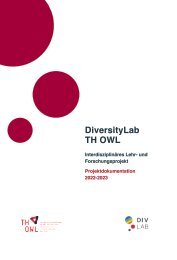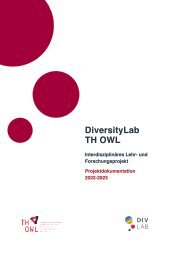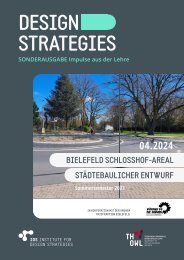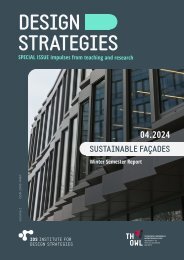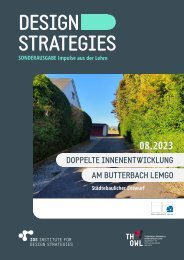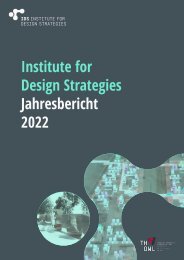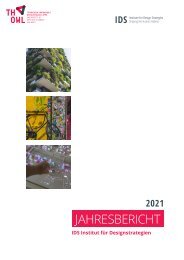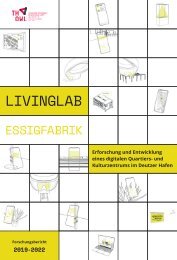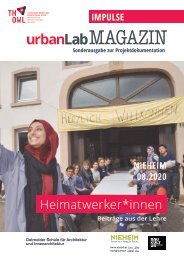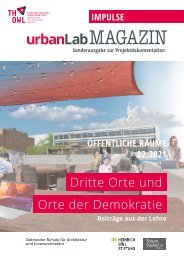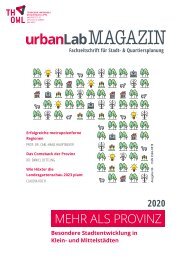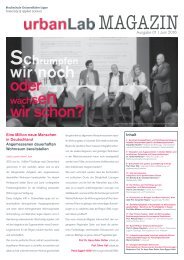urbanLab Magazin 2021 - Transformation
Erfolgreiche ePaper selbst erstellen
Machen Sie aus Ihren PDF Publikationen ein blätterbares Flipbook mit unserer einzigartigen Google optimierten e-Paper Software.
GreenScenario asks the question ‘what happens when I…’ to compare – visually,<br />
quantitatively and for multiple solutions simultaneously – the consequences of<br />
decisions undertaken during the planning and design process<br />
established community planning processes (Schroth, Pond, Sheppard, 2015). A potential<br />
solution combining these observations and gaining acceptance as a method<br />
within climate change adaptation planning is the application of ‘Scenario Planning’<br />
as a decision-support process that combines a rigorous, scientific assessment within<br />
the framework of multiple scenario (solution) generation (Star et al, 2016). Computational<br />
design techniques as they relate to developing digital decision-support<br />
systems or platforms, while found to be practical and implementable at building<br />
and plot scales, were found to be particularly challenging to apply at urban, regional<br />
and city scales due to increased computational expense, difficulty in limiting inputs,<br />
and the increase in involved stakeholders involved in the planning process (Wilson<br />
et al, 2019).<br />
By describing the findings of multiple projects where the GreenScenario methodology<br />
has been applied within the context of European cities with a specific focus on its use by a<br />
property developer in Vienna, the results aid in identifying enablers and barriers for the<br />
use and acceptance of decision-support tools for climate change adaptation planning.<br />
2 CLIMATE ADAPTATION AND DECISION-SUPPORT TOOLS<br />
By 2050, the cost of ‘doing nothing’ to mitigate climate change effects in cities is<br />
estimated to incur costs in the EU alone in the range of 100-150 billion Euros per<br />
year every year, dependent on the climate scenario (COACCH, 2018). Mitigating the<br />
effects of climate change tend to occur at larger city-wide or country specific scales<br />
and primarily refer to methods that reduce greenhouse gas emissions whereas climate<br />
change adaptation refers to processes, tools or actions that increase resilience,<br />
reduce vulnerability or enhance adaptive capacity, and tend to occur at regional,<br />
local or site-specific scales (IPCC 2018). As Nay et al (2014) indicate: ‘Climate adaptation<br />
strategies must be implemented at the local level.’ Adaptation measures have<br />
become recently more and more associated with resilience measures (Carter et al.,<br />
2015). Research shows that mitigation and adaptation tracks can be combined to<br />
enable synergies (Landauer, Juhola, Klein, 2019).<br />
Nature-based solutions (NBS) can be defined as ’actions to protect, sustainably manage,<br />
and restore natural or modified ecosystems, that address societal challenges<br />
effectively and adaptively, simultaneously providing human well-being and biodiversity<br />
benefits’ (IUCN, 2019). At the end of the 20th century, NBS tools (e.g. green<br />
roofs or rain gardens) began to emerge as suitable measures to complement or<br />
replace technical solutions that reduced the reliance on grey infrastructure such<br />
as piping or concrete channels, particularly within the landscape architecture discipline<br />
(OECD, 2020). With increasing rates of urbanisation, the subsequent loss of<br />
biodiversity and the detrimental effect on ecosystem services, adapting cities to the<br />
effects of climate change, rather than simply mitigating climate change’s impact and<br />
even with the aforementioned tools of NBS, is a major challenge exacerbated by the<br />
relative uncertainty, complex data interpolation and extended timespans associated<br />
with climate science. As Wilson et al further note: ‘Issues as diverse as population<br />
growth, transportation, and climate change, all present significant challenges<br />
for 21st century cities, and require an approach to urban development that is data-driven,<br />
iterative, and most importantly, engages the broadest possible audience<br />
of stakeholders’ (Wilson et al, 2019).<br />
REGENERATIVE DESIGN<br />
23




